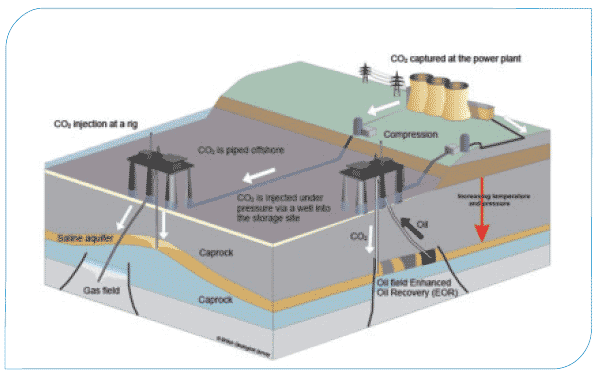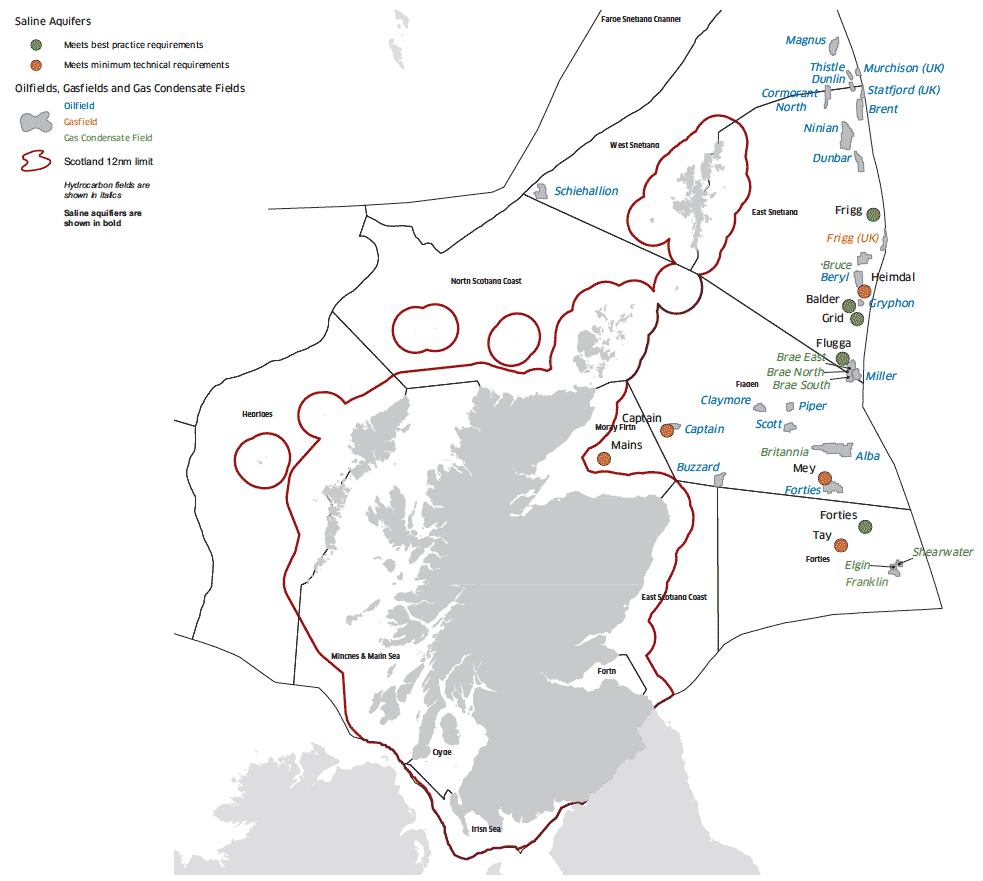Scotland's Marine Atlas: Information for The National Marine Plan
Scotland's Marine Atlas is an assessment of the condition of Scotland's seas, based on scientific evidence from data and analysis and supported by expert judgement.
CARBON CAPTURE AND STORAGE
What, why and where?
Carbon capture and storage ( CCS) is an approach being developed to manage emissions of CO 2. If it proves to be feasible and economically viable, CCS could capture approximately 80-90% of CO 2 emissions produced by fossil fuel power plants and heavy industry, transport them in liquid form by pipeline or ship, and subsequently inject them into geological formations deep underground where they are stored permanently below the earth's surface (1).
Scotland has vast potential for the geological storage of carbon under the seabed of the North Sea (1). CO 2 capture technologies could be applied to coal or gas-fired power generation. However the technology involved uses energy, which means it will probably reduce the efficiency of the power plant. CCS represents a major technological challenge and there are cost uncertainties and regulatory issues that still need to be resolved.
The amount of CO 2 produced from industrial sources within Scotland is about a tenth of that of the UK as a whole. Scotland is likely to produce between 300 and 700M tonnes of CO 2 from 2010 to 2050. This, on average, is between 8 and 18M tonnes per year (Mt/year) depending on the proportions and types of power generation, it is expected this will be mitigated through the progressive fitting of CCS to power generation, so that it is decarbonised by 2030.
Geological reservoirs suitable for storage of CO 2 are classified according to whether they contain (or have contained) oil, gas, or saline water. Saline aquifers have the largest storage potential but there is uncertainty about the storage capacity of individual sites. A study has investigated more than 80 saline aquifers and 10 have been identified for potential use. These have a potential capability to store more than 200 years of Scotland's current CO 2 output from its major fixed industrial sources (1).
Contribution to the economy
As an emerging technology CCS's potential value is unknown. Economic value is not yet available from the ABI. However, a research study Opportunities for CO 2around Scotland published in May 2009 (1), showed that Scotland has the storage capacity, the natural resources, the technology and opportunity to develop a significant CCS industry. There is potential capacity to store industrial CO 2 emissions from Scotland for the next 200 years.
The size of the potential storage opportunities under the North Sea could also be of importance to the whole EU, and to growing economies such as China and India, as a future carbon store. Although the technology requires development, Scotland is well placed to take a lead in this subsequent commercialisation.
An estimate of 10,000 jobs in clean fossil fuels, CCS in Scotland and the export of technology and services has been made but a breakdown of the marine related jobs is not available (2). Economic values cannot be attributed to sea areas for future CO 2 storage at this stage but there could be considerable benefits in the future, such as cost savings for organisations attempting to reduce emissions.
Pressures and impacts on Scotland's socio-economics
Positive
- Helps reach climate change targets
- Strengthens security of energy supply by enabling continued use of coal within the energy mix
- Contributes to economic growth by placing Scotland in a lead role in an emerging sector
- Uses existing pipelines and infrastructure no longer required for oil and gas
Negative
- None identified
Source: Based on CP2 PSEG Feeder Report s. 3.14.6 (3)
Pressures and impacts on the marine environment
The nature of environmental impacts may depend on the extent to which it is possible to use existing pipelines, installations and wells.
Pressure theme: Climate change and physical pressures
Pressure: Salinity increase
Impact: Use of salt caverns involves the injection of water and the possibility that brine (salt in solution) could flow up the well, forming a dense layer across the seabed. This may be highly toxic to marine organisms.
Pressure theme: Pollution and other chemical pressures
Pressure: CO 2 leakage into subsurface microbial systems
Impact: Leakage could cause local acidification with a permanent effect on marine habitats if it persists. Leakage into sea could change pH and affect microbial ecosystems and plankton dynamics.
Pressure: Introduction of non-synthetic substances and compounds
Impact: Solvents used in CCS and any discharged waters may carry contaminants. Produced water and scale volumes should be much less than for oil and gas production.
Pressure theme: Habitat changes
Pressure: Smothering and siltation rate changes
Impact: Physical loss /damage from construction (e.g. dredging) and decommissioning activities which may also reduce water quality.
Source: Based on CP2 PSEG Feeder Report Table 3.100 (3) (See also oil, gas, pipelines and gas storage section) and UK Marine Policy Statement (4)
Forward look
The energy sector is important to economic growth. To meet Scotland's climate change target of 80% reduction in greenhouse gas emissions by 2050, the electricity generation sector will need to be decarbonised by 2030. CCS could have an important role to play along with a substantial increase in renewable energy. New coal-fired power stations will need to demonstrate CCS on at least 300 MW (net) of capacity from the beginning of operation. Further new builds from 2020 would be expected to have full CCS.
There are three immediate challenges facing this emerging technology. The first is to demonstrate its economic and technical feasibility which, having been proven on a pilot scale at Longannet Power Station, will be taken forward through funding from the UK Government's CCS Demonstration Competition. The second is to ensure that the storage of CO 2 in geological formations is, in effect, permanent because the concept will not work if CO 2 leaks back to the surface even after many hundreds of years in storage. The third challenge is to develop the technology on a time scale that will allow it to capitalise on the oil and gas infrastructure within the North Sea in the form of pipelines and platforms before these are decommissioned and removed.
There are real economic opportunities in developing CO 2 storage hubs and pipeline networks for Europe. The Scottish Government published a Carbon Capture and Storage roadmap in March 2010. A follow up study to Opportunities for CO 2storage around Scotland will be published in 2011.
The CCS process from power station to seabed

© NERC, British Geological Survey
Location of 29 hydrocarbon fields and 10 saline aquifers identified as potential CO 2storage sites

Hydrocarbon fields assessed as having potential for CO 2storage
Field name |
Close of production |
Average water depth |
Estimated CO 2storage |
|---|---|---|---|
Brae North GC |
2015 + |
99 + |
52 |
Franklin GCHPHT |
2030 - |
93 + |
62 |
Elgin GCHPHT |
2030 - |
93 + |
63 |
Shearwater GCHPHT |
2015 + |
92 + |
66 |
Brae East GC |
2020 = |
116 = |
111 |
Britannia GC |
2030 - |
136 = |
181 |
Bruce GC |
2020 = |
122 = |
197 |
Frigg ( UK) Gas Field |
2008 + |
112 = |
171 |
Brent Oil Field |
2015 + |
140 = |
456 |
+ Parameter is technically or economically favourable
= Parameter is technically or economically borderline
- Parameter is technically or economically unfavourable
Source: 'Opportunities for CO 2 storage around Scotland' (1)
Note: GC = gas condensate field; HPHT = high pressure high temperature field
Saline aquifers assessedas having potential for CO 2storage
Saline aquifer |
CO 2storage |
CO 2storage |
|---|---|---|
Forties |
886 + |
8,856 + |
Grid |
785 + |
7,847 + |
Balder |
347 + |
3,465 + |
Flugga |
61 + |
611 + |
Frigg |
58 + |
575 + |
Mey |
1,655 = |
16,549 = |
Heimdal |
618 = |
6,177 = |
Tay |
133 = |
1,328 = |
Captain |
36 = |
363 = |
Mains |
24 = |
241 = |
Note: table shows range of potential storage capacities calculated from storage efficiencies derived from regional studies and regional modelling
There is a problem
Thanks for your feedback